#me in 2032 when i run out of ideas and i write a novel about felix and dorothy going to the grocery store
Text
me at 5:44am reading back on the word doc i just made detailing all the past, current, and future wips that take place in the revelations, revelations universe
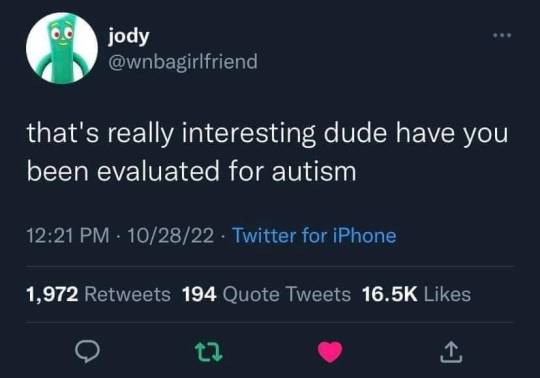
#THIS IS COMPLETELY /POS BTW I LOVE AUTISM I LOVE BEING SO AUTISTIC THAT I GET SUCH A STRONG AND UNIQUE JOY FR#FROM THIS FUCKING LITERARY UNIVERSE I MADE LOL#also the reason i have so many wips is because i am legit terrified of ever being finished with RR#the thought of moving on from RR literally paralyses me with distress#im gonna get any idea i can from this universe....#me in 2032 when i run out of ideas and i write a novel about felix and dorothy going to the grocery store
17 notes
·
View notes
Text
Why Octavia E Butler’s novels are so relevant today
It’s campaign season in the US, and a charismatic dark horse is running with the slogan ‘make America great again’. According to his opponent, he’s a demagogue; a rabble-rouser; a hypocrite. When his supporters form mobs and burn people to death, he condemns their violence “in such mild language that his people are free to hear what they want to hear”. He accuses, without grounds, whole groups of people of being rapists and drug dealers. How much of this rhetoric he actually believes and how much he spouts “just because he knows the value of dividing in order to conquer and to rule” is at once debatable, and increasingly beside the point, as he strives to return the country to a “simpler” bygone era that never actually existed.
More like this:
- The 1968 novel that predicted today
- The fiction that predicted space travel
- The story of cannibalism that came true
You might think he sounds familiar – but the character in question is Texas Senator Andrew Steele Jarret, the fictional presidential candidate who storms to victory in a dystopian science-fiction novel titled Parable of the Talents. Written by Octavia E Butler, it was published in 1998, two decades before the inauguration of the 45th President of the United States.
Like much of her writing, Butler’s book was a warning about where the US and humanity in general might be heading. In some respects, we’ve beaten her to it: a sequel to 1993’s Parable of the Sower, Parable of the Talents is set in what is still the future, 2032. While its vision is extreme, there is plenty that feels within the bounds of possibility: resources are increasingly scarce, the planet is boiling, religious fundamentalism is rife, the middle classes live in walled-off enclaves. The novel’s protagonist, a black woman like the author herself, fears that Jarret’s authoritarianism will only worsen matters.
Fourteen years after her early death, Butler’s reputation is soaring. Her predictions about the direction that US politics would take, and the slogan that would help speed it there, are certainly uncanny. But that wasn’t all she foresaw. She challenged traditional gender identity, telling a story about a pregnant man in Bloodchild and envisaging shape-shifting, sex-changing characters in Wild Seed. Her interest in hybridity and the adaptation of the human race, which she explored in her Xenogenesis trilogy, anticipated non-fiction works by the likes of Yuval Noah Harari. Concerns about topics including climate change and the pharmaceutical industry resonate even more powerfully now than when she wove them into her work.
And of course, by virtue of her gender and ethnicity, she was striving to smash genre assumptions about writers – and readers – so ingrained that in 1987, her publisher still insisted on putting two white women on the jacket of her novel Dawn, whose main character is black. She also helped reshape fantasy and sci-fi, bringing to them naturalism as well as characters like herself. And when she won the prestigious MacArthur ‘genius’ grant in 1995, it was a first for any science-fiction writer.
Octavia Estelle Butler was born on 22 June 1947. Her father, a shoeshiner, died when she was very young, and she was raised by her mother, a maid, in Pasadena, California. As an only child, Butler began entertaining herself by telling stories when she was just four. Later, tall for her age and painfully shy, growing up in an era of segregation and conformity, that same storytelling urge became an escape route. She read, too, hungrily and in spite of her dyslexia. Her mother – who herself had been allowed only a scant few years of schooling – took her to get a library card, and would bring back cast-off books from the homes she cleaned.
An alternate future
Through fiction, Butler learnt to imagine an alternate future to the drab-seeming life that was envisioned for her: wife, mother, secretary. “I fantasised living impossible, but interesting lives – magical lives in which I could fly like Superman, communicate with animals, control people’s minds”, she wrote in 1999. She was 12 when she discovered science fiction, the genre that would draw her most powerfully as a writer. “It appealed to me more, even, than fantasy because it required more thought, more research into things that fascinated me,” she explained. Even as a young girl, those sources of fascination ranged from botany and palaeontology to astronomy. She wasn’t a particularly good student, she said, but she was “an avid one”.
After high school, Butler went on to graduate from Pasadena City College with an Associates of Arts degree in 1968. Throughout the 1970s, she honed her craft as a writer, finding, through a class with the Screen Writers’ Guild Open Door Program, a mentor in sci-fi veteran Harlan Ellison, and then selling her first story while attending the Clarion Science Fiction Writer’s Workshop. Supporting herself variously as a dishwasher, telemarketer and inspector at a crisp factory, she would wake at 2am to write. After five years of rejection slips, she sold her first novel, Patternmaster, in 1975, and when it was published the following year, critics praised its well-built plot and refreshingly progressive heroine. It imagines a distant future in which humanity has evolved into three distinct genetic groups, the dominant one telepathic, and introduces themes of hierarchy and community that would come to define her work. It also spawned a series, with two more books, Mind of My Mind and Survivor, following before the decade’s end.
With the $1,750 advance that Survivor earnt her, Butler took a trip east to Maryland, the setting for a novel she wanted to write about a young black woman who travels back in time to the Deep South of 19th-Century America. Having lived her entire life on the West Coast, she travelled by cross-country bus, and it was during a three-hour wait at a bus station that she wrote the first and last chapters of what would become Kindred. It was published in 1979 and remains her best-known book.
The 1980s would bring a string of awards, including two Hugos, the science-fiction awards first established in 1953. They also saw the publication of her Xenogenesis trilogy, which was spurred by talk of ‘winnable nuclear war’ during the arms race, and probes the idea that humanity’s hierarchical nature is a fatal flaw.The books also respond to debates about human genetic engineering and captive breeding programs for endangered species.
In her author photos, Butler appears a serious woman with an exceptionally penetrating gaze. At a talk she gave in Washington DC in 1991, later reported in the radical feminist periodical, Off Our Backs, she offered a fuller description of herself: “comfortably asocial – a hermit in the middle of Los Angeles – a pessimist if I’m not careful, a feminist, a black, a former Baptist, an oil-and-water combination of ambition, laziness, certainty and drive”.
That certainty and drive can be seen in papers from her archive, now housed at the Huntington Library. In 1998, some motivational notes written on the back of a ring-bound writing pad begin “I shall be a bestselling writer!” She goes on: “I will find the way to do this! So be it! See to it!” Elsewhere, she’s to be found urging herself to “tell stories filled with facts. Make people touch and taste and know. Make people feel! Feel! Feel!”
Butler died in 2006, following a fall near her home in Washington state. Though she had begun suffering from writer’s block and depression, caused in part by medication for her high blood pressure, she’d continued to teach, and in 2005, had been inducted into Chicago State University’s international black writers hall of fame. She published a novel that year, too, Fledgling, whose vampire heroine must avenge a vicious attack, and rebuild her life and family. By then, her books had been translated into 10 languages, selling more than 1 million copies altogether.
In the years since, her fanbase has only grown. It turns out that she didn’t invent the campaign slogan beloved by Trump. It was used by Ronald Reagan in his 1980 presidential campaign, and later by Bill Clinton, although later he described the phrase as a “racist dog whistle to white southerners”. Nevertheless, as Tarshia L Stanley, dean of the school of humanities, arts and sciences at St Catherine University, notes, when readers spotted during the 2016 US election that Butler had chosen the slogan for Jarret, it “jarred people into recognising that she’s been doing this work all along. She’d been trying to tell us that if we do not make changes, this is what’s going to happen. She constantly gave that message: this is the logical conclusion if we keep treading down this path. I think when people saw that phrase, it started a whole new group of people reading her work.”
Butler’s work is today the subject of fan fiction, television adaptations (there are at least two in the works), and lively attention on college campuses, where it’s read from perspectives as varied as critical race theory, Afrofuturism, black feminism, queer theory and disability studies. Stanley, who last year edited the essay collection Approaches to Teaching the Works of Octavia E Butler, is also president of a society dedicated to the author. Its membership is broad, she says, but the most gratifying surprise is how many young people Butler’s work is engaging. At the inaugural conference, there was even a panel of high-school kids.
What would Butler have made of the present political moment in the US? “I don’t think she would have been surprised”, Stanley says. She puts Butler’s ability to envisage our future down to a deep understanding of human nature – knowledge gained from having the role of outsider foisted on her in girlhood. This she backed up with research, reading journals including Scientific American, listening to lectures, travelling as far as the Amazon. For Stanley, the one lesson to take from Butler’s work is hope. “World building is huge in her canon, and so there is always hope that since we built this world, we can build another one.”
There’s a scene in Parable of the Sower when the best friend of heroine Lauren Olamina insists “Books aren’t going to save us”. Lauren replies: “Use your imagination,” telling her to search her family’s bookshelves for anything that might come in handy. “Any kind of survival information from encyclopedias, biographies, anything that helps you learn,” she goes on. "Even some fiction might be useful".
Butler’s novels are just that kind of fiction. The child who began writing as a means of escape, ended up crafting potent calls to socio-political action that seem ever more pertinent to our survival as a species.
Parable of the Sower, Parable of the Talents, and other books by Octavia Butler are published by Headline.
[fmr]
#octavia estelle butler#octavia e. butler#octavia e butler#octavia butler#rip#novels#black author#black authors#black sci-fi#black sci fi#black lit#black literature#lit#literature#books#sci-fi#sci fi#speculative fiction#bbc#bbc news#long reads
4 notes
·
View notes
Photo
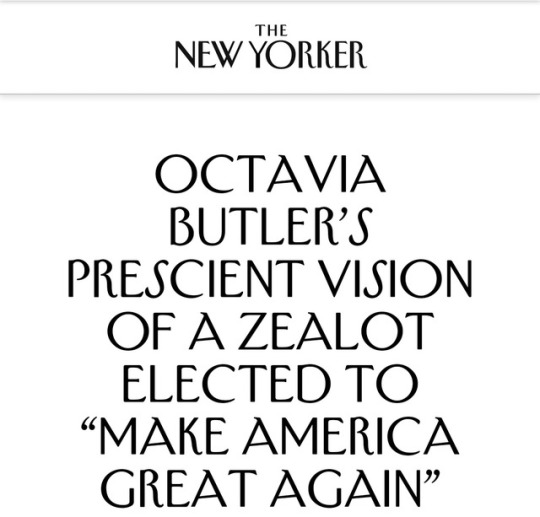
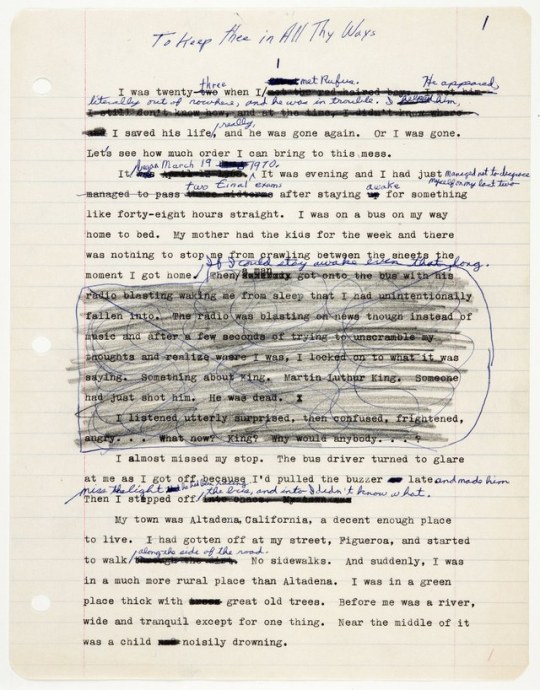
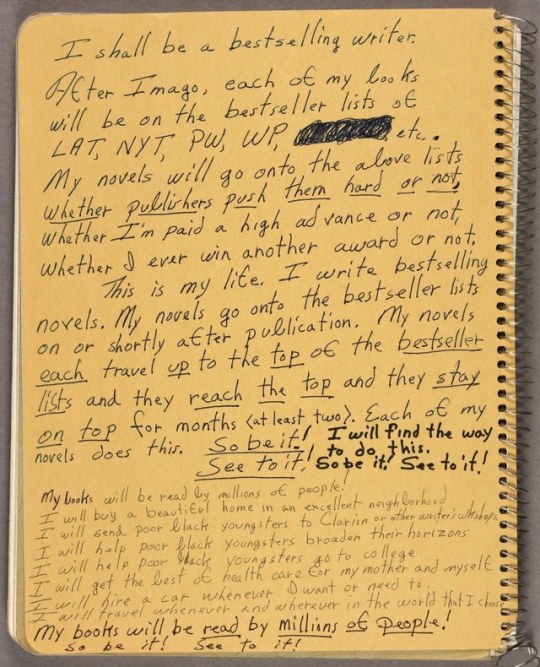

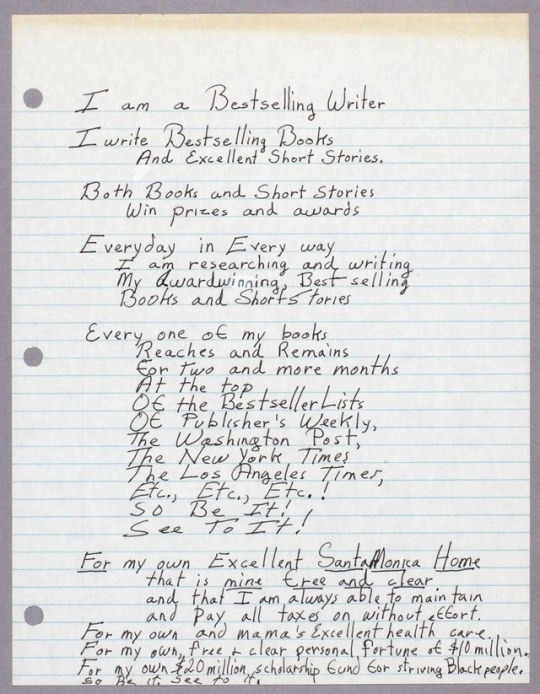
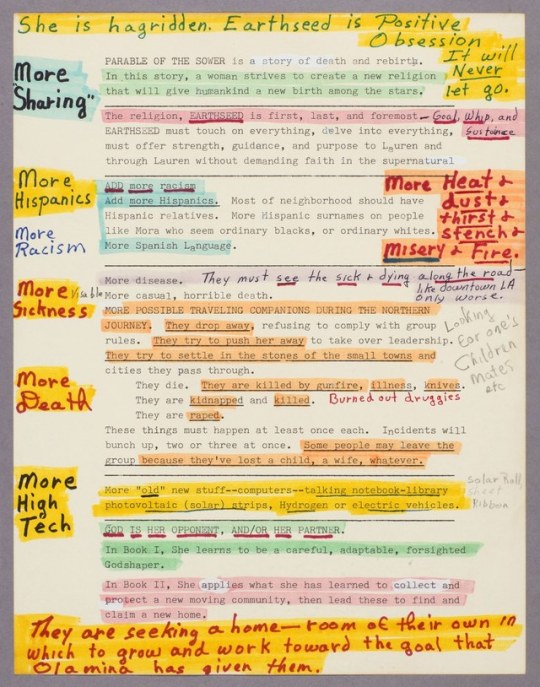
Octavia Butler’s tenth novel, “Parable of the Sower,” which was published in 1993, opens in Los Angeles in 2024. Global warming has brought drought and rising seawater. The middle class and working poor live in gated neighborhoods, where they fend off the homeless with guns and walls. Fresh water is scarce, as valuable as money. Pharmaceutical companies have created “smart drugs,” which boost mental performance, and “pyro,” a pill that gives those who take it sexual pleasure from arson. Fires are common. Police services are expensive, though few people trust the police. Public schools are being privatized, as are whole towns. In this atmosphere, a Presidential candidate named Christopher Donner is elected based on his promises to dismantle government programs and bring back jobs.
“Parable of the Sower” unfolds through the journal entries of its protagonist, a fifteen-year-old black girl named Lauren Oya Olamina, who lives with her family in one of the walled neighborhoods. “People have changed the climate of the world,” she observes. “Now they’re waiting for the old days to come back.” She places no hope in Donner, whom she views as “a symbol of the past to hold onto as we’re pushed into the future.” Instead, she equips herself to survive in that future. She practices her aim with BB guns. She collects maps and books on how Native Americans used plants. She develops a belief system of her own, a Darwinian religion she names Earthseed. When the day comes for her to leave her walled enclave, Lauren walks west to the 101 freeway, joining a river of the poor that is flooding north. It’s a dangerous crossing, made more so by a taboo affliction that Lauren was born with, “hyperempathy,” which causes her to feel the pain of others.
By writing black female protagonists into science fiction, and bringing her acute appraisal of real-world power structures to bear on the imaginary worlds she created, Butler became an early pillar of the subgenre and aesthetic known as Afrofuturism. (Kara Walker cites her as an inspiration; and, as Hilton Als has pointed out, Butler is the “dominant artistic force” in Beyoncé’s visual album “Lemonade.”) In the ongoing contest over which dystopian classic is most applicable to our time, Kellyanne Conway made a strong case for George Orwell’s “Nineteen Eighty-Four” when she used the phrase “alternative facts” and sent the novel to the top of Amazon’s best-seller list. Margaret Atwood’s “The Handmaid’s Tale” also experienced a resurgence in sales, and its TV adaptation on Hulu inspired protest costumes. But for sheer peculiar prescience, Butler’s novel and its sequel may be unmatched.
Butler was born in 1947, in Pasadena, California, and raised by her grandmother and mother, who worked as a maid. Her father, a shoe shiner, died when she was seven. As a child, she often accompanied her mother to work at a wealthy Pasadena household, where the help entered through back doors. In one of Butler’s first stories, “Flash—Silver Star,” which she wrote at the age of eleven, a young girl is picked up by a U.F.O. from Mars and taken on a tour of the solar system.
Butler ignored the received idea that black people belonged in science fiction only if their blackness was crucial to the plot. (In 1979, a fellow-science-fiction writer advised Butler that points about race might better be made with extraterrestrials.) As she wrote in a 1980 essay for the magazine Transmission, titled “Lost Races of Science Fiction”: "No writer who regards blacks as people, human beings, with the usual variety of human concerns, flaws, skills, hopes, etc., would have trouble creating interesting backgrounds and goals for black characters.” She later made a habit of explaining, as here to the Times, “I wrote myself in, since I’m me and I’m here and I’m writing. I can write my own stories and I can write myself in.”
In “Octavia E. Butler: Telling My Stories,” an exhibition of Butler’s papers at the Huntington Library, in San Marino, California, which runs through August 7th, there is tangible evidence of her outsize resolve. Over the decades, as she was writing her most popular novel, “Kindred,” and two highly regarded series—her five-part Patternist books and her Xenogenesis trilogy—Butler was filling personal journals with affirming mantras. “I am a bestselling writer,” one entry, dated 1975, reads. “I write bestselling books.” She closes: “So be it! See to it!” She was still talking to herself in this manner in 1988, even though by then she had won both a Hugo and a Nebula award, science fiction’s highest honors. “I shall be a bestselling writer,” she writes in a notebook that year. “So be it! See to it!”
By the time she began working on the Parable books, in 1989, Butler was in her forties and had written nine novels. The series, she decided, would be her “If this goes on…” story. In colorful diagrams, Butler extrapolated her vision of a near-future dystopia from what she read in the news, forecasting what kind of collapse might result if the forces of late-stage capitalism, climate change, mass incarceration, big pharma, gun violence, and the tech industry continued unhampered. (“More Hispanics,” she writes in one notebook. “More High Tech.”) Butler took a cyclical view of history. She also thought social progress was reversible. As the public sphere became hollowed out, a fear of change would create an opening for retrograde politics. With collapse, racism would become more overt.
The sequel, “Parable of the Talents,” published in 1998, begins in 2032. By then, various forms of indentured servitude and slavery are common, facilitated by high-tech slave collars. The oppression of women has become extreme; those who express their opinion, “nags,” might have their tongues cut out. People are addicted not only to designer drugs but also to “dream masks,” which generate virtual fantasies as guided dreams, allowing wearers to submerge themselves in simpler, happier lives. News comes in the form of disks or “news bullets,” which “purport to tell us all we need to know in flashy pictures and quick, witty, verbal one-two punches. Twenty-five or thirty words are supposed to be enough in a news bullet to explain either a war or an unusual set of Christmas lights.” The Donner Administration has written off science, but a more immediate threat lurks: a violent movement is being whipped up by a new Presidential candidate, Andrew Steele Jarret, a Texas senator and religious zealot who is running on a platform to “make American great again.”
In Butler’s prognosis, humans survive through an intricate logic of interdependence. Soon after leaving her family’s walled neighborhood, Lauren discerns that her natural allies are other people of color, including mixed-race couples, since they are likely to become targets of white violence. Several of the migrants who join Lauren’s pack and the community she later establishes, Acorn, turn out to also be “sharers,” the term for people with hyperempathy. But Butler is not making a sentimental case for the value of empathy. In the day to day of the Parable books, hyperempathy is a liability that makes moving through the world more complicated and, for tactical reasons, requires those who have it to behave more ruthlessly. When defending herself against attackers, Lauren often must shoot or stab to kill, or else risk being immobilized by the pain she inflicts. In one particularly dark manifestation of the syndrome, she is raped and experiences both her own pain and the pleasure of her rapist.
In 1995, Butler became the first science-fiction writer to be awarded a MacArthur fellowship. The grant, she hoped, would enable her to finish four more books she had planned for the Parable series. But the story, she found, was “too depressing.” She changed course and wrote a vampire novel, her last book, “Fledgling,” which came out in 2005. The following year, Butler died unexpectedly, at the age of fifty-eight, when she fell and hit her head outside her home, north of Seattle. In her lifetime, Butler insisted that the Parable series was not intended as an augur. “This was not a book about prophecy,” she said, of “Talents,” in remarks she delivered at M.I.T. “This was a cautionary tale, although people have told me it was prophecy. All I have to say to that is: I certainly hope not.” [x]
Images:
A page from a working draft of Octavia Butler’s novel “Kindred,” with handwritten notes and the novel’s original title, circa 1977.
The back cover of one of Butler’s personal journals, from 1988.
A sample of Butler’s notes on writing, circa 1970-95.
A motivational entry in one of Butler’s personal journals, from 1988.
An outline and notes from Butler’s novel “Parable of the Sower,” circa 1989.
#octavia e. butler#octavia e butler#octavia butler#make america great again#donald trump#the new yorker#rip
2 notes
·
View notes